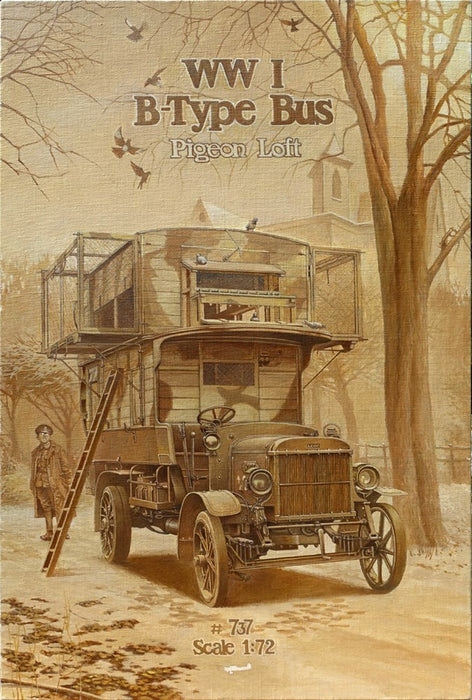
Roden 737 1:72 Type B WWI Bus "Pigeon Loft"
$5 COURIER DELIVERY within NZ for all orders over $99 NZD!
From its start in the summer of 1914, the demands of the First World War provided the impetus for the development of the latest developments and technologies. It was at this time that the first warplanes, tanks and submarines appeared. In the context of hostilities over large areas, the problem of coordination between individual units became increasingly important, as the means of communication at that time still remained relatively imperfect.
The telegraph already existed, but mobile devices were relatively heavy and unreliable, and their use was accompanied by constant technical problems. Faced with the question of communication, military commanders compromised and decided to use a tool often employed in earlier conflicts, namely birds, as a connection to the location of previous deployment. The amazing ability of certain species of birds, pigeons in particular, to return to their homes from a great distance would once again save the lives of many soldiers in the coming years of the Great War.
A special miniature container was attached to the bird's foot, in which a note with a message could be placed. Given the fact that the speed of the pigeon could be up to 60 miles per hour (almost 100 km per hour), despite this rather archaic method the message could be delivered to its destination quite quickly.
Another factor was the possible destruction of the bird - for example, by heavy fire from enemy positions. This problem was overcome by the widespread use of pigeons, sending messages of the same content at the same time, carried by a large number of birds.
As early as 1914, during an intense German offensive towards Paris near the River Marne, pigeons released from their "lofts" delivered an important message to the command headquarters about the critical situation in this area, which allowed troops to regroup and prevent calamitous developments for the Allies.
In the following years of the Great War, despite the fact that the field telegraph continued to improve, communication with the help of birds still played an important role. Thus, in October 1918, when the conflict was almost at its end, a unit of American troops surrounded by the Germans released several birds with a note calling for immediate help. One of the birds named Cher Ami brought this urgent message to the headquarters in half an hour, and the unit was soon freed from the enemy's encirclement. For this act, the bird was given one of France's highest awards - the Order of the Croix de Guerre, which by any measure is a remarkable achievement.
To transport a large number of birds together special mobile carriages were used, the so-called "pigeon lofts". Initially, they were horse-drawn trailers, and later double-decker B-type buses were used as mobile bird shelters, which had now changed scene from the streets of London to the front lines of contact with the enemy on the Western Front.
Some of the two-story vehicles were rebuilt in order to perform their new task; the passenger seats on both levels were removed, the windows on the first floor were shuttered with boards, and the fence on the second floor was replaced by windows, cut out and covered with nets through which birds could fly simultaneously at the required time.
